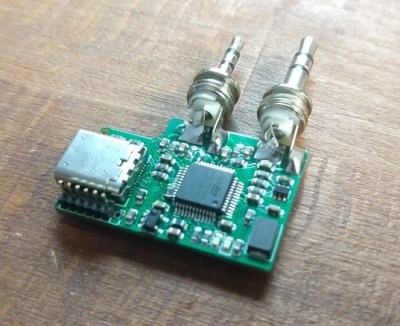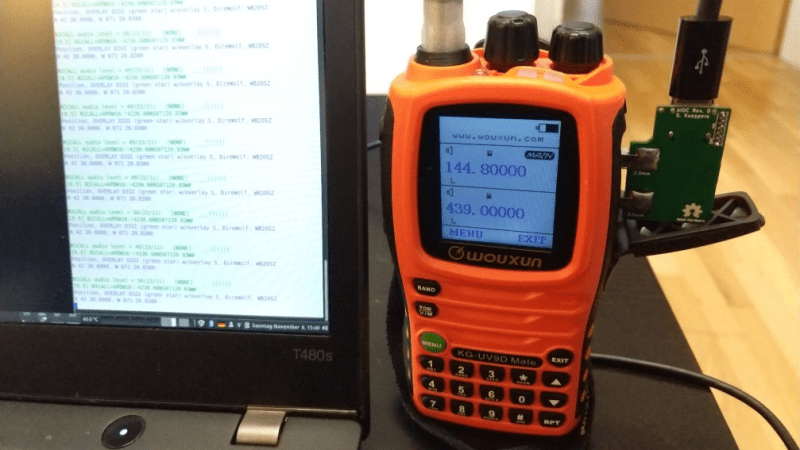The Ham Radio All-in-one cable (AIOC) is a small PCB attachment for a popular series of radio transceivers which adds a USB-attached audio interface and virtual TTY port for programming and the push-to-talk function. The STM32F373 microcontroller (which, sadly is still hard to find in the usual channels) is a perfect fit for this application, with all the needed hardware resources.
With USB-C connectivity, the AIOC enumerates as a sound card as well as a virtual serial device, so interfacing to practically any host computer should be plug-and-play. Connection to the radio uses 12mm separation 3.5mm and 2.5mm TRS connectors, so is compatible with at least the Baofeng UV-5R but likely many other cheap transceivers that have the same physical setup.
sound card as well as a virtual serial device, so interfacing to practically any host computer should be plug-and-play. Connection to the radio uses 12mm separation 3.5mm and 2.5mm TRS connectors, so is compatible with at least the Baofeng UV-5R but likely many other cheap transceivers that have the same physical setup.
Instructions are provided to use the AIOC with Dire Wolf for easy access to APRS applications, which makes a nice out-of-the-box demo to get you going. APRS is not all about tracking things though since other applications can sit atop the APRS/AX.25 network, for example, HROT: the ham radio of things.
We’ve seen quite a few Baofeng (and related products) hacks, like this sketchy pile of wires allowing one to experiment with the guts of the radio for APRS. Of course, such cheap radio transceivers cut so many engineering corners that there are movements to ban their sale, so maybe a new batch of better radios from our friends in the East is on the horizon?
Thanks to [Hspil] for the tip!
















There is no link to project details in the article.
https://github.com/skuep/AIOC
I had PCBway make up a few boards, the BOM and everything were for a earlier Rev, but came back looking good. Have not bootstrapped one yet however.
The changes in Revision were mainly small overall size differences and changing the LDO to a 2-channel one (analog/digital) for better noise immunity. But nothing critical, the firmware should be compatible.
Best Regards
Simon (Original Author)
I’m always using galvanic insulation, preferably through a transformer. ^^
Oh, and I’m using a quality soundcard with good linearity, good snr and a high sampling rate. 24-Bit resolution isn’t unwelcome, either. ;)
Especially for SDR use cases (IQ mixer), a real line-in is better than mic-in.
For mic-in users: Please don’t forget to use a capacitor in line with the audio. Depending on the pinout, it’s necessary, because mic-in has what’s commonly called ‘phantom voltage’.
I like Direwolf. It has FX.25, which is awesome for APRS. If only digipeater operators would upgrade their setup to accordingly. *sigh*
It would get real APRS back at eye level with that funky LORA “APRS”.
RE: FX.25
Not a fan of APRS—but what every floats your ship :)
I run FX.25(via UZ7HO and DIREWOLF ) on all my nodes. Both HF
and VHF. FX.25 really, really helps on HF!!
So YES— ALL packet should be using FX.25!!
“LAZY” — 7.104LSB/145.77 Gateway
And—-
We DON’T need YET another non-compatible mode like IL2P.
FX.25 IS backward compatible with normal AX.25 packet.
I will have a nasty Email by the end of the day.
Mandatory XKCD reference
https://xkcd.com/927/
>We need to develop one universal standard that covers everyone’s use cases
Hi, Simon here, the original author of the project.
Thanks for the shout-out! 🙂
Currently, mainly due to availability, the project uses a STM32F302 (not 373). It turns out, the 12-bit ADC is more than enough for radio purposes.
I am currently working on supporting multiple samplerates so that you can use it with aprsdroid, albeit without PTT support currently (there is an active issue with the aprsdroid project for that).
Galvanic isolation did not seem necessary until now, however I have only used HT radios until now.
The best thing about the AIOC is, that it is simpler to build for the general public, than the alternatives (it’s just one chip and a few passives that you can order fully assembled from JLCPCB). It is also more hackable, because it does not use commercial sound cards chip, but microcontroller. It’s also cheaper than the alternatives due to smaller BOM.
Best regards
“Galvanic isolation”
I have been interfacing modems to radios for over 30 years
and have found that the “Galvanic isolation” is not needed
near as much as some claim. Laptops seem to be the biggest
problem I have found. A LOT of laptops need isolation.
Is it a bad idea? No— Required?? — Sometimes, not always.
Many times a simple ceramic cap inline is all that’s needed.
(To get the DC off the line)
YMMV
Stupendously great effort. Thank you so much for releasing this.
GD32 to the rescue.
Remember that transmitting on amateur radio frequencies requires an FCC license with appropriate band privileges.
Only in the US. Other countries have similar rules, but different administrative organizatiins.
Good point! I tend to think locally. You are right, other countries will have their own agency for granting privileges on the airwaves. Get the license first , then hit the PTT. Thanks.
Would be fantastic if a particular site had the concept of tags and could appropriately tag those things likely to need a license.
Maybe they could tag them with skills used too, such that users could choose articles with care skills they are compatible with or are looking to gain.
It does have tags…
“Transmitting legally” . Absolutely nothing stopping anyone from doing it if they choose to. 1000’s do daily
Nice, it’s a Digirig Mobile (https://digirig.net/digirig-mobile-rev-1-9/) with less parts.
I fear however that in real life use (carrying this radio while walking, running), the two TRS-plugs will easily be torn off the PCB. The TRS-plugs also limit the use to HTs with this specific pinout.
Maybe replace the two TRS-plugs by a single TRRS-socket so that the ‘standard’ (and more compact) converter cables from Mobilinkd can be used?
I think if you just went out with the PCB hangng off the side of the radios then yes, you’d be resoldering them regularly but a little bit of hamgenuity and it’s trivial to create a small, 3D printed case that snugged up into the recess on side of the radio to give a load of support.
Wouldn’t be difficult to use flying leads or an add-on ‘carrier’ PCB to move the PCB and or suit many other radios either.
A suggestion . Use a cable with that double TRS plug. Then solder the end onto the board in an appropriate enclosure! ZS1BTD!
The connectors are used on countless radios, not just Baofeng but also kenwood, TYT, etc.
The connectors are a TRS and a TRRS.
I don’t think the intended use case is to be attached to a radio while walking, since the board requires a computer on the end of the USB cable to ‘drive’ the board.
This would be compatible with the Wouxun UV9PX. Is there something similar that could be created for the Yaesu FTM-300DR style radios? Currently, there is not a good way to control PTT.